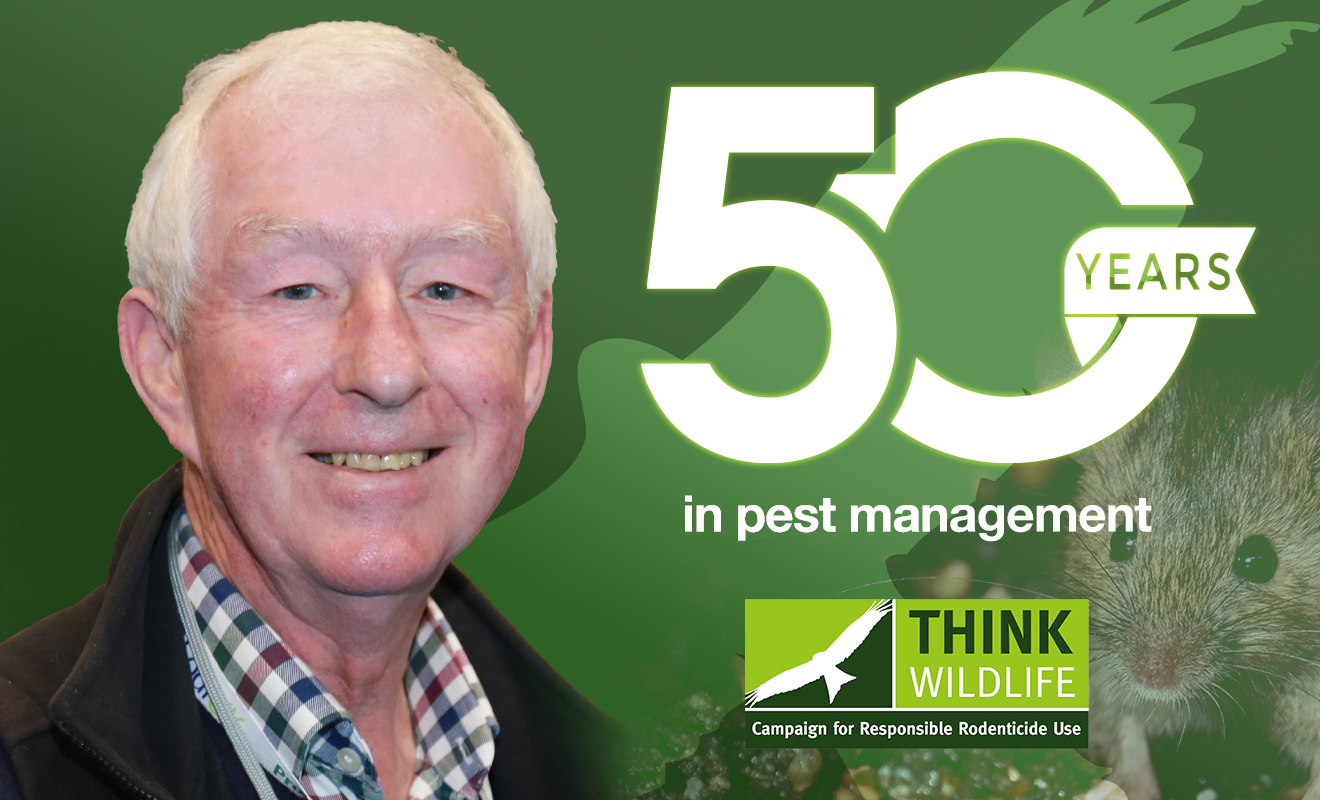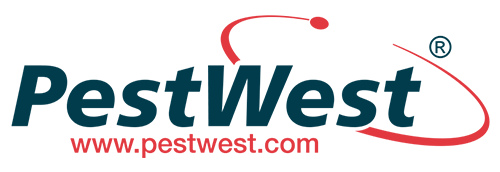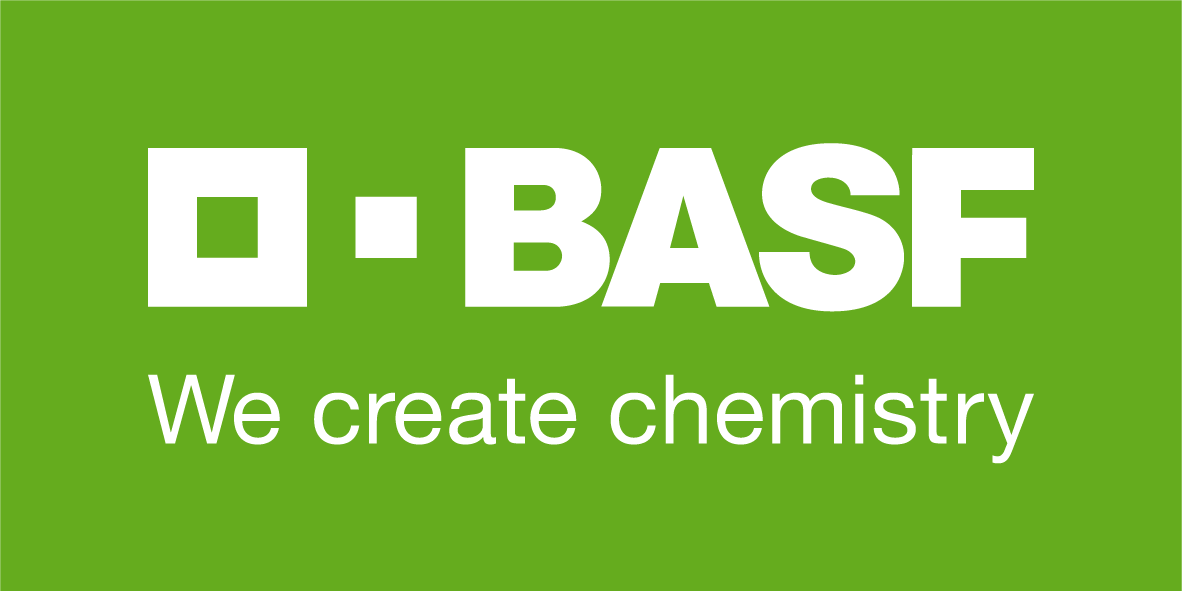Dr Alan Buckle, Visiting Research Fellow at the University of Reading and Chair of the Campaign for Responsible Rodenticde Use (CRRU UK) reflects with PCN on over 50 years in pest management.
Alan retires from his CRRU role at the end of April 2024, with a
stellar career that has shaped the pest management industry
for just over half a century. Many of our readers will be familiar
with Alan as the Chair and driving force of the Campaign
for Responsible Rodenticide Use (CRRU UK), the industry
stewardship regime that has preserved the use of anticoagulant
rodenticides when they were under threat of withdrawal.
However, while the contribution of CRRU has been and continues
to be hugely significant, there is much more to thank Alan for.
Hinting at some early
highlights, to whet one’s
appetite to read on, Alan
was instrumental in the
development of anticoagulants
in the first place! We wouldn’t
have certain anticoagulant
active ingredients and
formulations without the work
of him and his co-workers
and it is almost certain these
products would not remain
without the efforts of CRRU UK.
Early research
Having graduated from Royal Holloway College, University
of London, with a 1st class honours degree in Zoology,
Alan completed a PhD there on the ‘Insect epifauna of
British wild small mammals’, tracking marked fleas moving
between Wood mice to see who was living with who.
Alan’s contributions to pest management began as early
as 1973, when he started research at Aston University
(Birmingham, UK) that led to the development and
commercialisation of a novel technology for mouse control.
Alan met Mary Eastaugh at university. They married in
1974 and celebrate their golden wedding anniversary
in July this year. They have two daughters, Laura and
Karen, and in spite of Alan’s many and often long absences
travelling abroad, Mary ably juggled being a mother to
the girls with a successful career as a maths teacher.
Development of key anticoagulants and formulations
From Birmingham to the rice of fields of Malaysia…where
Alan worked on the control of (Rattus argentiventer) the
‘Rice field rat’. Alan owes his start to Fred Rowe, who was
the house mouse specialist in the UK Ministry of Agriculture
and his mentor in Malaysia and the UK for ten years.
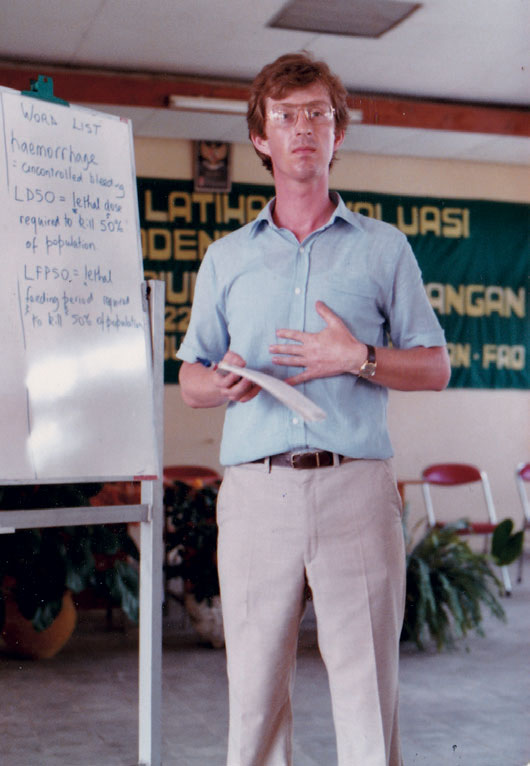
Development of key anticoagulants and formulations
Development of key anticoagulants and formulations
From Birmingham to the rice of fields of Malaysia…where
Alan worked on the control of (Rattus argentiventer) the
‘Rice field rat’. Alan owes his start to Fred Rowe, who was
the house mouse specialist in the UK Ministry of Agriculture
and his mentor in Malaysia and the UK for ten years.
Seconded to the Malaysian Ministry of Agriculture, his work
included damage assessment and damage surveys, field
efficacy tests, rodenticide resistance, developing wax blocks
and reduced baiting methods for brodifacoum baits, leading
to the pulsed baiting concept. On departure for Malaysia,
Alan remembers instructions from the project’s boss, David
Drummond, pioneer of anticoagulant resistance work in the
UK. David said, “If you ever do a project that involves catching a rat and letting it go again, I’ll have you back home before you
know what’s hit you.” David was one of the ‘don’t study them
get rid of them’ school, that is so different to current thinking.
Malaysia also involved a cobra bite and stay in rural hospital.
Alan remembers two other ‘patients’ in the ward. One was
a cat that slept on the bed opposite the whole day, while in
the next bed was a communist terrorist, hand-cuffed to the
bed-frame and guarded by a police officer with a shotgun!
Luckily the bite responded quickly to anti-venom but resulted
in a tricky phone call to Mary back on Penang Island.
I think many of us take wax blocks and ‘pulsed baiting’
for granted – now we know some of the history!
Insecticides
While the Global Research and Development Manager at ICI, Alan
was responsible for R&D of all formulations of the insecticide
active ingredients permethrin, cypermethrin, lambda-cyhalothrin
and pirimiphos-methyl. Bringing his expertise to Syngenta in the
early 2000’s, Alan led projects on Vector and Professional Pest
Management insecticides under the brand name ‘Icon’, which
included microencapsulated formulations of lambda-cyhalothrin,
wettable powder formulations and treated malaria bednets.
Travels / international reach
With the move from
Birmingham to Malaysia already
mentioned, Alan undertook
vertebrate pest management
projects in South-East Asia and
has directed further research
in many countries around the
world. Both at ICI and as part
of his later work at Alan Buckle
Consulting Ltd, he has consulted
on management of vertebrate
alien species on islands of
high conservation status
including projects on Madeira
and neighbouring islands with
his friend Frank Zino, and
in the Caribbean, Mauritius,
Galapogos, Africa and the UK.
As part of an industrial role,
there have also been projects
on barn owls as a biological
control of rats in oil palm.
All the travel gave Alan a taste
for exotic foods. This unfortunately led to cholera after a sushi seaurchin
dinner in Manila. The flight to Bangkok that night was spent
in the loo and ended on a stretcher and an ambulance ride. The
last he remembered on waking three days later in intensive care
was an A&E doctor saying ‘if we don’t get this guy’s blood pressure
up we’re going to lose him!”. The career nearly ended there!
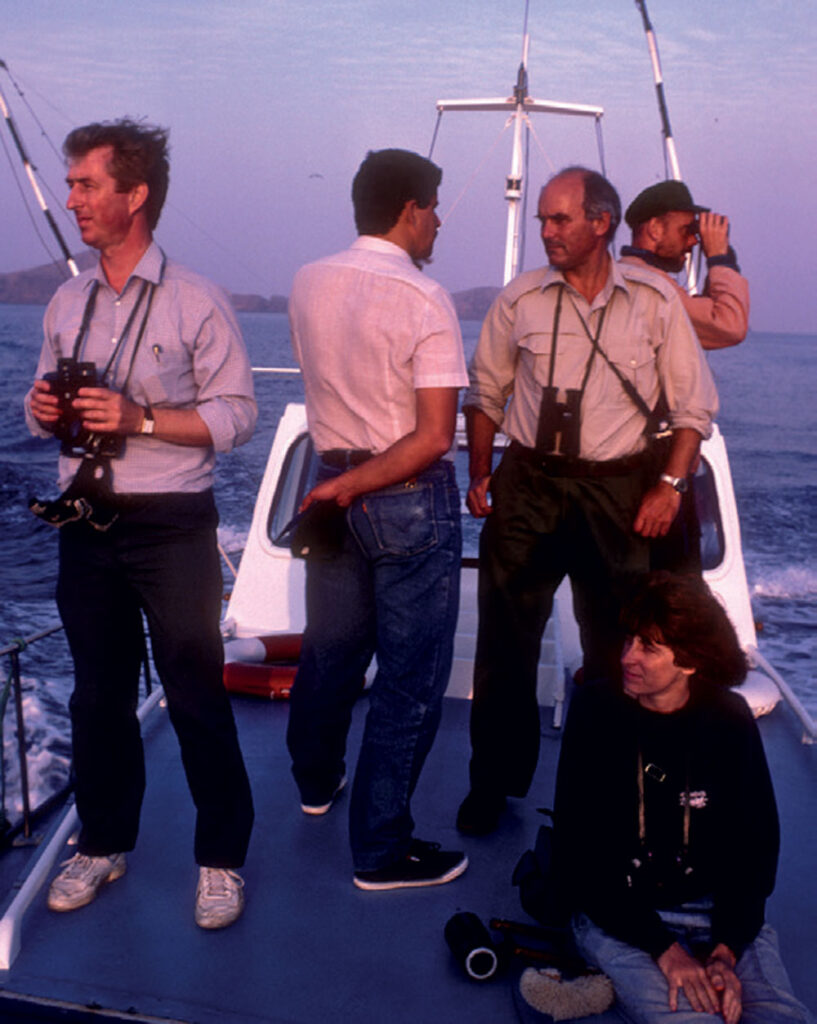
Industry stewardship
When Alan retires from his CRRU role, he will have held the position of Chairman for over 20 years.
Alan doesn’t take credit for starting
CRRU. In fact, it began when a small
group of like-minded industry people,
including the late Jonathan Peck of
Killgerm and Ian Pepper of Rentokil
Initial, decided something needed to be
done about wildlife exposure to SGARs,
which was becoming an inceasing issue.
Alan was soon appointed as Chairman
and, as they say, ‘the rest is history’.
Development of the UK rodenticide stewardship regime
The development of a stewardship
framework was not easy, taking three
years of hardwork. There were the
conflicting positions and interests
of different user groups and the
requirements of government to reconcile.
Some stakeholders walked out but later
came back. Alan led the CRRU team
trying to pull it all together and there
were countless meetings with usergroup
representatives and government,
including a meeting with the minister
responsible for HSE. Three different
proposals went from CRRU to government.
Rupert Broome, who was beside Alan
thoughout, remembers the first was
received with the response ‘be more
ambitious’ and the second with ‘almost
there’. Finally, a third set of proposals
was agreed with HSE and accepted to
meet its ‘High Level Principles’ (https://www.hse.gov.uk/biocides/rodenticides.htm) and stewardship could begin.
Implementation of the UK rodenticide stewardship regime
Training and certification
One of stewardship’’s most
important requirements is that all
who buy professional rodenticide
products must show proof of
competence at the point of sale.
Best practice
Many aspects of rodenticide application
practice are now supported by published
CRRU guidelines, many of which Alan
has written or co-written. The most
important of these being the CRRU
Code of Best Practice, a revision of
which was produced in July 2021.
Monitoring
A framework of monitoring has also
been introduced covering all aspects
of the regime, including residues in
wildlife, anticoagulant resistance,
barn owl breeding and understanding
and adoption of best practice.
Strengthening the regime
However, after seven years of the regime
and with environmental targets still
unmet, it became clear to Alan, CRRU
directors and other CRRU stakeholders
that changes were required. So a
series of strengthening measures is
now being implemented with two main
objectives: to reduce wildlife exposure to
rodenticides and to keep SGARs available
to all user groups in the essential use
scenario – ‘in and around buildlings’.
One measure to control levels of
anticoagulant residues in barn owls,
is that sales of products containing
bromadiolone and difenacoum for use
in open areas and at waste dumps
will cease on 4 July 2024. These
products purchased on or before
that date will be authorised for use
in open areas and waste dumps until 31 December 2024. After that,
it will be illegal to use any SGAR
product to treat a rodent infestation
not associated with a building.
The CRRU Code of Best Practice offers
a range of effective methods for rodent
management away from buildings,
including elimination of harbourage,
food and water; lethal non-anticoagulant
baits; and trapping, shooting and dogs.
Adding further strength to stewardship
– from January 2026 onwards, all buyers
and users of professional SGAR products
must hold either a stewardship-specific training certificate less than five years
old, or an older one with proof of
membership of a stewardship-specific
Continuing Professional Development
(CPD) scheme. As five-year certificate
expiry dates approach, holders can
either repeat the training and requalify,
or join a CPD scheme. Most recently,
further rigour has been applied to
training and certification with a
requirement that CRRU-approved
courses are Ofqual regulated.
This complex and nationally-implemented
stewardship regime is entirely operated
by voluntary contribution of resources
from the CRRU stakeholder organisations
and member companies. Pest Control
News and Alan offer grateful thanks
to those organisations, and to the
individuals involved, and on behalf of
all whose livelihoods depend on our
continued ability to conduct effective
rodent pest management to protect
human and animal health and hygiene.
One of stewardship’’s most
important requirements is that all
who buy professional rodenticide
products must show proof of
competence at the point of sale.
Finally, what with cobras and cholera,
you could be forgiven for thinking that
Alan is accident prone! But there’s
more! A few years ago he contracted
leptospirosis when he scratched his arm
working in a garden compost heap that
had months earlier been home to a rat.
It is a salutary story that Alan stood in
front of three NHS doctors, including
one in A&E, and told them what he had.
All said it was ‘flu and sent him home.
Finally, late one night Mary thought she
was going to lose him and went to a GP
she knew. Antibiotics were immediately
prescribed and acquired at an all-night
pharmacy. Recovery was very quick
after that and blood tests at Porton
Down eventually confirmed lepto!



